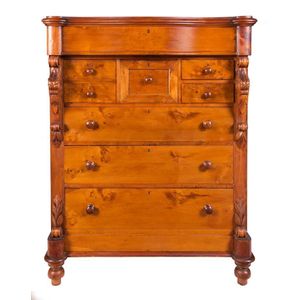Serpentine Huon Pine Chest with Carved Corbels (9 words)
You must be a subscriber, and be logged in to view price and dealer details.
Subscribe Now to view actual auction price for this item
When you subscribe, you have the option of setting the currency in which to display prices to $Au, $US, $NZ or Stg.
- Huon Pine - Named after the Frenchman who discovered the Huon River in Tasmania, it is an extremely slow growing and long living tree. Huon pine is native to Tasmania, and it can grow to an age of 3,000 years or more. The wood contains oil that retards the growth of fungi, hence its early popularity in ship-building in convict-era Tasmania. The timber is a warm yellow colour, finely grained, and was popular for household furniture in the Victorian era. Interestingly, much Huon pine furniture was made in South Australia. Huon pine is a protected species and only limited quantities are available nowadays, for craftsmen to manufacture small items such as platters, sculptures and other decorative objects.
- Corbel - An architectural term for a support for a projecting bracket, ostensibly supporting a beam or horizontal feature, but used in bookcases, sideboards and chests as a decorative element. Corbels are often carved with acanthus or other scrolling decoration.
- Circa - A Latin term meaning 'about', often used in the antique trade to give an approximate date for the piece, usually considered to be five years on either side of the circa year. Thus, circa 1900 means the piece was made about 1900, probably between 1895 and 1905. The expression is sometimes abbreviated to c.1900.
- Serpentine - Resembling a serpent, in the form of an elongated 'S'. A serpentine front is similar to a bow front, except that the curve is shallow at each end, swelling towards the middle. The term presumably derives from its similarity to a moving snake or serpent. Serpentine fronts are usually veneered, with the carcase either being cut and shaped from a solid piece of timber, or built in the 'brick' method.
This item has been included into following indexes:
- chests of drawers, material
- chests of drawers, style - eight drawer 85
Visually similar items

Huon pine tallboy chest of drawers, circa 1890 with bobbin turned pilasters, 210 cm high, 162 cm wide, 60 cm deep

A George III mahogany chest on chest, early 19th century, 175 cm high, 115 cm wide, 53 cm deep

Huon pine chest: eight drawers with serpentine front, carved columns & beautiful birdseye figuring. Late 19th century. H.140 x 116 x 53 cm

An impressive birdseye huon pine chest of 8 drawers with cantilever top and unusual carved figural corbels, Tasmanian origin, circa 1840, 143 cm high, 115 cm wide, 59 cm deep
